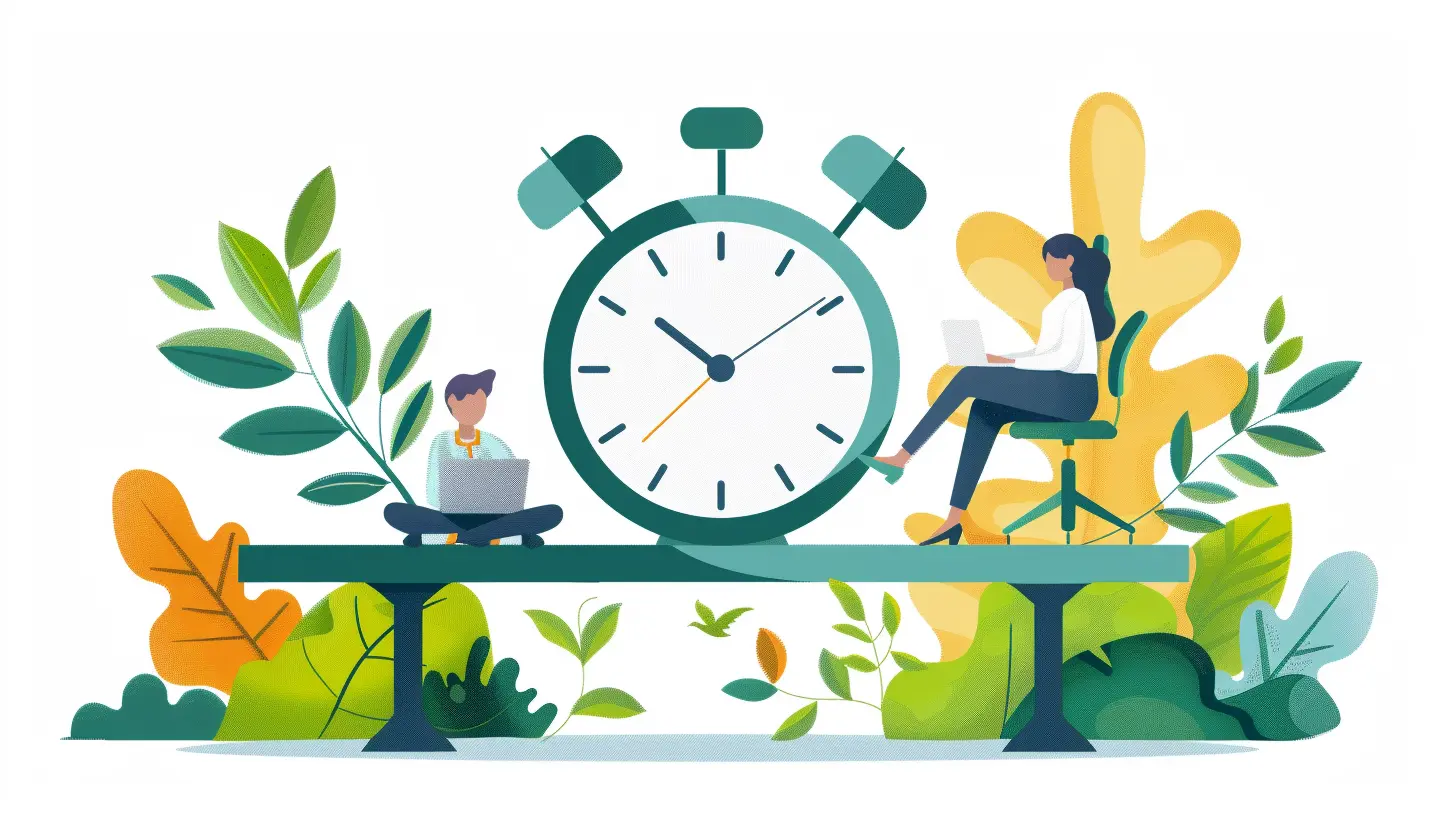The Evolution of Work-Life Balance in a Digital Era
17 August 2025
Let’s be real for a second—work-life balance used to be as simple as clocking out at 5 PM and heading home. Done. Game over. But somewhere along the way, emails started buzzing at all hours, Zoom meetings crept into weekends, and the lines between "work" and "life" got blurry. Welcome to the digital era.
These days, achieving true work-life balance feels more like walking a tightrope than a nine-to-five schedule. With Wi-Fi connections stronger than ever and smartphones basically glued to our hands, the workplace is no longer just a place—it's everywhere. But here’s the thing: technology isn’t all bad. In fact, it’s been a big part of what has transformed work-life balance into something more flexible, personal, and, honestly, trickier.
Let’s dive into how this whole thing evolved, what it means for us now, and how we can actually tip the scales back in our favor.
The Good Ol’ Days: A Clock-In, Clock-Out World
Not too long ago, work-life balance was simple. You had an office. You had a home. And there wasn’t much overlap.Before the digital revolution, people worked fixed hours. They left their tasks at work when they went home. Sure, some jobs demanded more time, but for the most part, when you walked out of the office, your time was yours.
Do you remember the days when “urgent” meant tomorrow morning, not “reply within the hour”? Yeah, those were the days.
Enter the Digital Revolution: The Game Changer
Then came the internet, email, smartphones... and boom! The entire dynamic shifted. With technology making everything faster and more connected, suddenly work didn’t stay neatly tucked inside office walls anymore.Think about it: now you can answer Slack messages while at your kid’s soccer practice or knock out a report while still in your pajamas. Sounds great, right? Well, yes and no.
Technology gave us the gift of flexibility. But at the same time, it opened the floodgates. The workday no longer had a clear beginning or end. In this digital era, work goes where you go.
The Rise of Remote Work: A Blessing and a Curse
Remote work—once a rare perk—is now completely mainstream. Especially after the COVID-19 pandemic, working from home became the new normal. Millions traded desks for kitchen tables and suits for sweatpants.On one hand, remote work gave people more freedom. No commuting. More time with family. Fewer distractions (depending on your household, of course). You could even work from a beach in Bali if the Wi-Fi was good enough.
But on the flip side? The lines between personal life and work blurred even further. Suddenly, your home became your office. And without those physical boundaries, it became hard—really hard—to “switch off.”
Hustle Culture & The Always-On Mentality
Here’s another curveball: hustle culture. It romanticizes overworking and glorifies burning the candle at both ends. “Sleep when you're dead!” they say. Or “Rise and grind!”And while ambition isn't a bad thing, constantly being “on” isn’t sustainable. Digital tools—like Slack, Zoom, Asana—make it so easy to stay connected that disconnecting can seem, well… wrong.
But here’s the kicker: always being available doesn’t make you more productive—it makes you more stressed. The digital era promised freedom, but instead, it often delivers burnout.
New Expectations: Employees Want Balance, Not Burnout
Work-life balance isn’t just a “nice-to-have” anymore. It’s a must-have. Today's workforce—especially Millennials and Gen Z—value quality of life just as much as their paychecks. And companies are catching on.We're seeing a shift. Flexible hours. Four-day work weeks. Unlimited PTO policies. Mental health days. These aren’t just buzzwords. They’re signs that companies are finally waking up to the reality that overworked employees don’t perform better—they quit faster.
People want meaningful work, yes. But they also want time to breathe, live, and just be human.
Remote Work Tools That Help (and Sometimes Hurt)
Let’s talk tools—because they’re a big part of this evolution. Most workplaces are powered by some combination of:- Zoom for meetings
- Slack or Microsoft Teams for messaging
- Project management tools like Trello, Asana, or Monday.com
- Cloud platforms like Google Workspace or Microsoft 365
These platforms help streamline workflows and keep teams connected. But let’s not ignore the dark side. Constant pings, messages, and task updates can create a sense of urgency that never truly ends.
Have you ever caught yourself checking work emails during dinner? Or replying to a Slack message on a Sunday morning? Yep, that’s the digital leash.
The Role of Boundaries in a Connected World
So, how do we reclaim balance when our digital lives are so entwined with work?The answer lies in boundaries. That means:
- Closing the laptop at a set time every day
- Turning off push notifications after hours
- Taking real breaks (no “working lunches”)
- Actually using vacation time (radical, I know)
Boundaries don’t make you lazy. They make you sane. And in a remote-first world, they’re more important than ever.
Redefining Productivity in the Digital Age
Here’s a wild thought: what if productivity isn’t about how busy you are, but how effective you are?Old-school thinking equated long hours with hard work. But the digital era is challenging that. Now, it’s about working smarter, not longer.
Being busy all day but getting nothing done? That’s not productive. That’s just exhausting.
The trick is focusing on results, not time spent. It’s about output, not hours. And when we shift that mindset, work-life balance becomes a whole lot easier to achieve.
Mental Health: The Hidden Cost of Digital Burnout
Let’s not sugarcoat it—mental health has taken a hit in this always-connected culture. Anxiety, burnout, isolation—these are real issues people are dealing with.Remote work can be lonely. The pressure to always be accessible can be overwhelming. And the lack of separation between work and life can feel suffocating.
That’s why more businesses are investing in employee wellness programs, offering mental health resources, and encouraging time off. Because at the end of the day, a healthy employee is a productive one.
The Future of Work-Life Balance: What’s Next?
So, where are we headed?Honestly, the future looks hybrid. A mix of remote and in-office work, tailored schedules, and personalized routines. It’s about giving people control over when, where, and how they work best.
Flexible doesn’t mean lazy. It means adaptable. And that’s the name of the game in today’s world.
Technology will continue to evolve—AI, automation, virtual reality—but the human need for balance won’t change. What will change is how we get there.
The goal? To make work fit into life, not the other way around.
Real Talk: Tips for Finding Your Own Balance
Okay, enough theory. Let’s get practical. Here are a few ways to bring more balance into your digital work life:1. Set actual work hours – And stick to them like you would a meeting.
2. Use tech to your advantage – Apps like Focus Keeper or Calm can help manage time and stress.
3. Create a workspace at home – Even a small dedicated area helps your brain separate work from chill mode.
4. Unplug regularly – No emails after 7 PM. Really. Try it.
5. Speak up – Talk to your manager about workload or boundaries. Silence helps no one.
Remember, balance looks different for everyone. It’s not about getting it perfect. It’s about getting it right for you.
Final Thoughts: It's a Balancing Act
The digital era didn’t kill work-life balance. It just reinvented it.Yes, constant connectivity can be overwhelming. But it also gives us choice. The key is not to let technology control us, but to use it in ways that support our health, happiness, and productivity.
Work-life balance isn’t something that just happens. It’s something you actively create—every day.
So take a breath. Log off when you need to. And remember: work is just one part of your life—not your whole life.
all images in this post were generated using AI tools
Category:
Work Life BalanceAuthor:

Amara Acevedo
Discussion
rate this article
1 comments
Gunnar Frye
This article insightfully captures the transformation of work-life balance in today's digital landscape. As remote work blurs boundaries, understanding the importance of mindful tech usage and mental well-being is crucial. Emphasizing flexibility and personal time can lead to a more productive and satisfied workforce.
September 3, 2025 at 4:54 AM

Amara Acevedo
Thank you for your thoughtful comment! I'm glad you found the article's insights on mindful tech usage and flexibility in work-life balance valuable. Your perspective on mental well-being is essential in today's digital landscape.


